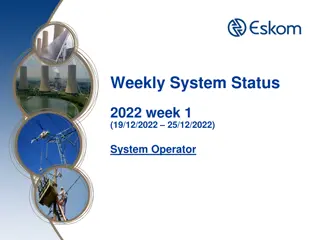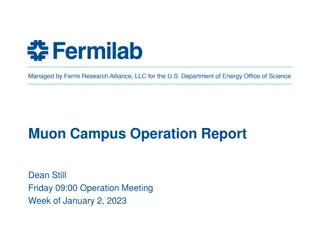
Understanding Memory Mapping and Struct Padding
Explore the concepts of memory mapping and struct padding in C programming, with a focus on handling bitmap files. Learn how to adjust struct declarations to ensure proper data alignment and prevent unexpected values. Get insights on using command-line options efficiently with POSIX getopt().
Download Presentation

Please find below an Image/Link to download the presentation.
The content on the website is provided AS IS for your information and personal use only. It may not be sold, licensed, or shared on other websites without obtaining consent from the author. If you encounter any issues during the download, it is possible that the publisher has removed the file from their server.
You are allowed to download the files provided on this website for personal or commercial use, subject to the condition that they are used lawfully. All files are the property of their respective owners.
The content on the website is provided AS IS for your information and personal use only. It may not be sold, licensed, or shared on other websites without obtaining consent from the author.
E N D
Presentation Transcript
What did we talk about last time? FIFOs Memory-mapped files
Memory map a bitmap file read in from the user Then, write out the contents of the header, which should match the following struct: struct BitmapHeader { unsigned char type[2]; unsigned int size; unsigned int reserved; unsigned int offset; unsigned int header; unsigned int width; unsigned int height; unsigned short planes; unsigned short bits; unsigned int compression; unsigned int dataSize; unsigned int horizontalResolution; unsigned int verticalResolution; unsigned int colors; unsigned int importantColors; }; // always contains 'B' and 'M' // total size of file // always 0 // start of data from front of file // size of header, always 40 // width of image in pixels // height of image in pixels // planes in image, always 1 // color bit depths, always 24 // always 0 // size of color data in bytes // unreliable, use 72 when writing // unreliable, use 72 when writing // colors in palette, use 0 when writing // important colors, use 0 when writing
When we do this, we'll get unexpected values for size, width, and height The problem is one that's important when dealing with memory directly Struct members are typically packed to fall on certain boundaries In this case, the unsigned int values will fall on 4-byte boundaries That means that the struct we defined expects two unused bytes after type but before size To fix this problem, we surround the struct declaration with the following statements: #pragma pack(push, 2) // Set packing size to 2 bytes #pragma pack(pop) // Pop 2 off, restoring old size
Assignments and projects for this class frequently use command- line options Dealing with them can be annoying, so POSIX provides getopt() to help: int getopt(int argc, char * const argv[], const char *optstring); argc and argv are the usual argument values passed into main() optstring is a string containing: Characters for any flag you want to give (such as g for a -g flag) With a colon afterwards when there are arguments (such as o: if there's an argument for the -o flag)
Typically, getopt() is called repeatedly Whenever a legal option is found, the char value associated with that option is returned If the option has an argument, it's stored in the global variable optarg For unrecognized options, '?' is returned When all options have been processed getopt() returns -1 The global variable optind contains the index of the first element in argv that isn't an option or option argument getopt() moves around the contents of argv so that all the options appear first
Consider a program that runs the following code in its main() int value = 0; while ((value = getopt(argc, argv, "co:")) != -1) { switch (value) { case 'c': printf ("Compile but do not link\n"); break; case 'o': printf ("Output: %s\n", optarg); break; } } printf ("Current argument: %s\n", argv[optind]); It's looking for: A -c option with no argument A -o option with an argument
Now this executable (program) is run: ./program goats.c -o result c The output will be: Output: result Compile but do not link Current argument: goats.c Likewise, argv will have been rearranged so that all options are first: argv ./program -o result -c goats.c NULL 0 1 2 3 4 5
Write a program that uses getopt() to respond to the following command-line options: -a Print "aardvark" -b Print "bat" -c Print "cat" -m name Print "a mammal of type name" Any other flag Print "unknown animal" After all the flags have been processed, print how many non- flag arguments are left
POSIX is a series of standards for operating systems tied closely to UNIX standards macOS is POSIX compliant in many ways but not for the IPC topics we're doing now Linux is mostly POSIX compliant Windows is not POSIX compliant, but there are environments like Cygwin that create mostly POSIX compliant environments For this kind of IPC, you have to use System V standards on macOS
POSIX IPC function refer to IPC object named with a string that follows a particular format: It must start with a slash It must have one or more non-slash characters Example: /comp3400_mqueue Object names must be unique These objects often appear as files in the file system, but you shouldn't interact with them using normal file commands POSIX IPC connections also have two other (familiar) values: oflag: Access needed, a bitwise OR of flags like O_RDONLY, O_WRONLY, O_RDWR, O_CREAT, and O_EXCL mode: Permissions, a bitwise OR of flags like S_IWUSR and S_IRGRP
Message queues are a form of message-passing IPC But don't we already have pipes and FIFOs? Differences from pipes: Messages are sent as units: one whole message is retrieved at a time Message queues use identifiers, not file descriptors, requiring special functions instead of read() and write() Messages have priorities, not just first-in-first-out Messages exist in the kernel, so killing off the sending process won't destroy them The big difference is structure: Pipes and FIFOs send bytes, and the reader can read any number of available bytes at a time Message queues send messages as units
POSIX message queues have additional features that other implementations, like System V, might not have POSIX message queues: Are only removed once they're closed by all processes using them Include an asynchronous notification feature that allows processes to alerted when a message is available Have priority levels for messages Allow application developers to specify attributes (such as message size or capacity of the queue) via optional parameters passed when opening the queue
mqd_t mq_open (const char *name, int oflag, ... /* mode_t mode, struct mq_attr *attr */); Open (and possibly create) a POSIX message queue. int mq_getattr(mqd_t mqdes, struct mq_attr *attr); Get the attributes associated with a given message queue int mq_close (mqd_t mqdes); Close a message queue int mq_unlink (const char *name); Remove a message queue's name (and the message queue itself, when all processes close it) int mq_send (mqd_t mqdes, const char *msg_ptr, size_t msg_len, unsigned int msg_prio); Send a message with a given length and priority ssize_t mq_receive (mqd_t mqdes, char *msg_ptr, size_t msg_len, unsigned int *msg_prio); Receive a message into a buffer and get its priority
Finish message queues Shared memory Semaphores
Finish Project 1 Due tonight by midnight! Read sections 3.7 and 3.8 Exam 1 next Monday!






















